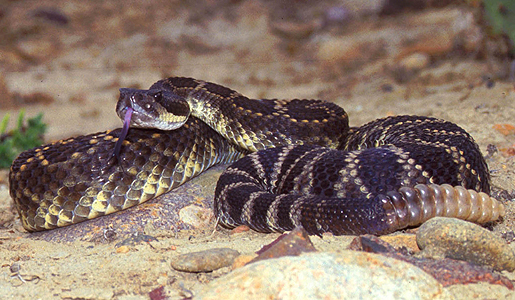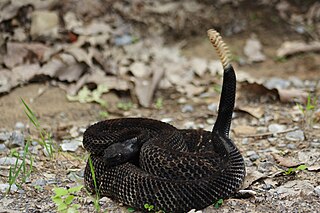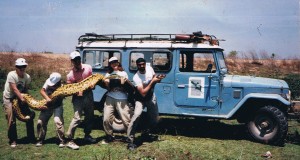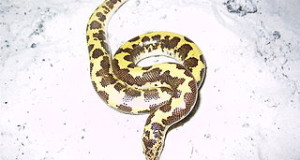I’ve spent decades working with venomous snakes, setting-up snakebite protocols in zoos, and responding to snakebite emergencies. Today, I’m sometimes criticized for my strong stand against the keeping venomous snakes in private collections. But I have learned that, even under the best of circumstances, treatment can be hampered by gaps in our knowledge. For example, we know that the chemical characteristics of venom vary over the ranges of certain species. This can affect treatment, and, as we’ll see below, may mean the difference between life and death for a victim. In fact, the venom of some Southern Pacific Rattlesnakes is so unique that it is unaffected by the antivenin currently in use! Are they the most dangerous snake in the USA?
Rattlesnake Venom and Antivenin
We’ve known for some time that the venoms of most snakes contain both haemotoxic (attacking blood vessels) and neurotoxic (attacking nerves) properties, with one or the other predominating. The venoms of several rattlesnakes have both, but the effects of most are haemotoxic in nature.
The antivenin administered to rattlesnake bite victims was formulated with that rule in mind. A single antivenin is used to treat bites from any of the 34 species native to the USA.
The Most Dangerous Snake in the USA? One Subspecies, Two Distinct Venoms
The Southern Pacific Rattlesnake (Crotalus oreganus helleri) is considered to be one of the most medically significant rattlesnakes in the USA. Researchers from the University of Queensland analyzed the venoms produced by two separate populations of this species. The populations studied are located in southern California, within a two hour’s drive from one another.
Southern Pacific Rattlesnakes living near Phelan, CA. produce fairly “typical” rattlesnake venom that attacks the blood vessels of a victim with anticoagulants and other compounds.
However, Southern Pacific Rattlesnakes living near Idyllwild, CA – 2 hours away by car – manufacture venom that could not be more different than that of their Phelan neighbors. Highly neurotoxic in action, this venom kills by paralyzing the nervous system (as is commonly seen in cobra bites).
Why Evolve Unique Venom?
Over time, certain prey animals evolve resistances to the venoms of their major snake predators. Snakes may respond with evolutionary changes of their own. Venom may eventually become “fine-tuned” to kill one or several specific prey animals.
For example, the venom of Timber Rattlesnakes (Crotalus horridus) living in New England is more effective against the most common local prey animal (gray squirrels, I believe) than against other creatures. Further south, cottontail rabbits predominate in the diet, and the venom’s chemical make-up reflects this. Timber Rattlesnakes living on St. Catherine’s Island off Georgia (formerly used by the Bronx Zoo to breed endangered species) seem to produce especially virulent venom, at least where dogs are concerned.
The Southern Pacific Rattlesnake populations mentioned above represent the greatest known venom variation within a species, and the distance involved is the shortest documented. Researchers theorize that the isolation of the Idyllwild population, which occupies mountain ridges near and over 4,000 feet above sea level, partially accounts for their unique venom.
Questions remain as to why neurotoxic venom has evolved among these snakes. One proposed explanation is found in the nature of the habitat, which is rocky and studded with caves and crevices. Rattlesnakes bite their prey and then withdraw, tracking their victims once they have expired. Perhaps the fast-acting neurotoxic venom allows snakes to more easily locate their victims. This may not be a consideration for snakes living in prairies and other open habitats.
Complications for Snakebite Victims
As mentioned earlier, the antivenin administered to rattlesnake bite victims in the USA was formulated to counteract the effects of “typical” rattlesnake venom, which is largely haemotoxic in nature. It is believed that people bitten by a Southern Pacific Rattlesnake living near Idyllwild would not be helped by this antivenin.
Certain populations of Mojave Rattlesnakes, C. scutulatus and the Neo-Tropical Rattlesnake, C. durissus, have long been known to contain neurotoxins. If I recall correctly from my days at the Bronx Zoo, bites from these species were treated with a mix of 2-3 antivenins (I’ve not checked current treatment recommendations; please post below if you need further information).
An abstract of original article (Journal of Proteomics, 24 Jan 2014) is available here.
Further Reading
Venomous Snakebite: My Experiences & a Surprising Study
The Eastern Diamondback Rattlesnake
Working with the Aruba Island Rattlesnake
 That Reptile Blog – Reptile, Amphibian and Exotic Pet Care and Information
That Reptile Blog – Reptile, Amphibian and Exotic Pet Care and Information






My immediate question is – How similar to Mojave rattlesnake venom is the Idyllwild population’s venom? Has there ever been a documented clinical case arising from a bite from one to substantiate the suspicion that the antivenin wouldn’t be effective? The current predominant and recommended antivenin in the US for a bite from any of the native rattlesnakes (including the Mojave) is CroFab, which is manufactured in part with antibodies from the Mojave rattlesnake (also the Eastern and Western Diamondbacks, and the Water Moccasin). The older antivenin was Wyeth ACP. I suppose the argument could be made that there is cause for concern and to study effectiveness of CroFab against that specific Idyllwild venom…but your article seems to raise alarms without posing anything more than a suspicion that the current antivenin wouldn’t “help”. It was noted in the journal article that the Idyllwild population’s neurotoxin component was consistent with Mojave toxin (hybridization?). Further on the journal article, I see overall what they were saying is not necessarily that the Idyllwild population itself was what was so dangerous, but that the extreme variability of hemotoxins among differing C. o. helleri populations as a whole is what is regarded as so dangerous. Mileage being extremely variable in using CroFab, depending on where the particular Southern Pacific individual came from.
Hello,
Thanks for your interest. Mojave bites have long been a concern…as mentioned, I don’t recall how we responded in recent past, will check shortly. Re the author’s reasons for questioning the use of the currently-recommended antivenin, I believe that is being investigated at this point. You might be able to receive an update by emailing one of the researchers (see abstract, linked at end of article); I’ll post an update when I have new info as well.
best, Frank
Wide space line/band on carapace between scales all at same level and down midline of plastron on ‘healthy’ Roussian T- most likely too fast a rate of growth/over feeding??
Hello,
Very hard to say based on growth lines alone, unfortunately, especially if there are no shell abnormalities, but captives always exhibit far more, and wider ones, than wild; I’ve seen 5 year old African Spurred Tortoises that would have been aged at 30+ via growth rings! Whether this will affect longevity, breeding potential depends on many factors, and upon species. Sorry I could not be of more help, best, Frank
YOU CAN GOOGLE SOUTHERN PACIFIC RATTLESNAKE IDYLLWILD now and find 2 stories in the Town Crier–one about my dog that was killed by the lethal neurotoxic venom of this snake–and one about another dog. The snake that bit my dog either did not envenomate the dog with the “typical” rattlesnake venom–as the article above states, these snakes have both–or it was a young snake that had not yet developed the enzymes that cause swelling at the bite site in their victims. YES this is a very lethal snake. my dog was healthy and fit but was dead in 2.5 hrs and the vets in the area had the wrong antivenom. Even if they had the CroFab, by the time we got to the vet, a 30-minute drive, he could barely breathe and had severe internal bleeding and seizures. We’re working on a group to be sure the antivenom is available here in Idyllwild, both for dogs and for humans.
Thank you, Kathy…sorry to hear the news, but admirable that you are bringing attention to the problem. Similar venom evolution has been documented in many species…yet people continue to keep venomous snakes as “pets”! Good luck in your endeavors, please keep me posted when you have a chance. Frank
I’m sorry to hear about your dog Kathy Keane. I would say though that since CroFab wasn’t tried, and since there was some delay in treatment, that it can’t be stated from this anecdotal case that CroFab would be ineffective. There needs to be clinical case studies where CroFab was used and failed if a new antivenin needs to be developed, and so far there aren’t any cited here.
Hello,
Research is or will soon be underway…until then it is wise to err on the side of caution and to be prepared in whatever way may be possible, as a bite may require experimentation on the part of the attending physician. This has been the case with other species that have exhibited similar venom evolution, etc. Please see the link to the original article abstract as well, Best, frank
Mike, I am not sure how you read into my Comment an implication that CroFab would have been ineffective?!? I was simply stating that here in my small town of Idyllwild, and at the closest veterinarian I could get to with my dog, CroFab was not available. If CroFab had been administered soon after his envenomation, I’m sure he would have survived. However, the seizures and internal bleeding that result from the neurotoxin killed my dog within 2.5 hours so it must be administered as soon as possible.
That is why we are trying make CroFab available here in my town. One of our two medical facilities has offered to carry it if our foundation can assist with its purchase (the cost is $3000/vial or more) but we’re still working on finding a veterinarian who can be on-call to administer it and the other treatments necessary (an endotracheal tube–one of the venom’s symptoms is closure of the airway–and an ice bath other treatment to lower body temperature–another symptom of the neurotoxic venom.
California Veterinary Specialists (CVS) in Murrieta treated a dog bitten by a Southern Pacific Rattlesnake (positvely identified by the dog’s owner, a herpetologist, who killed and delivered the dead snake to the veterinarian after the bite). Approximately one hour had elapsed by the time the dog arrived at CVS, but it was another 2.5 hrs before CVS was able to acquire CroFab from a local hospital. Among other treatments, the veterinarian there administered 5 vials of CroFab to the dog, a 6-kg Dachshund. The dog eventually died from pneumonia as a result of the ventilator used during his treatment.
Thank you very much…the cost is another aspect that “pet keepers” often fail to appreciate. In my time I’ve seen 10-15 vials of various types used to treat snake bites here in NYC.
Best regards, Frank
We are also Idylllwild residents with 3 small dogs and have had this on our property not knowing it’s danger as compared to other rattlers.
Would like to help if Kathy can contact us. Please advise us on emergency treatment as the closest vet is at least 45 to 60 minutes.
Thanks for the great info.!
What are the top 10 most deadly rattlesnakes in california?
Hello,
California has 7 native rattlesnake species; photos and information can be found here; a bite from any is dangerous and could potentially be fatal, but there is not an effective way to rate them due to the many variables involved. best, Frank